Taking stock of US Treasury bond "tokenization" fixed-income products, operating models, and concerns.
What is the "benchmark interest rate" for the crypto market? In 2022, UST/Anchor, through a method akin to "stepping on one's own feet to ascend," achieved a fixed annual yield of 20%. However, it ultimately destroyed this grand vision and initiated a painful period of declining interest rates in the DeFi market.
Times change, and so do circumstances. The 10-year U.S. Treasury yield, often referred to as the 'anchor of global asset pricing,' has been climbing quarter by quarter. On October 20, 2023, it even briefly surpassed the 5% mark, reaching a 16-year high not seen since July 2007. As of this writing, it remains high at 4.3%.
Under the circumstances of one declining and the other rising, the continuously soaring U.S. Treasury yields have also stimulated a group of institutions to launch a large number of 'tokenization' projects supported by U.S. Treasuries through the RWA channel since 2023. The fixed-income track in the crypto market is also beginning to enter a new golden age.
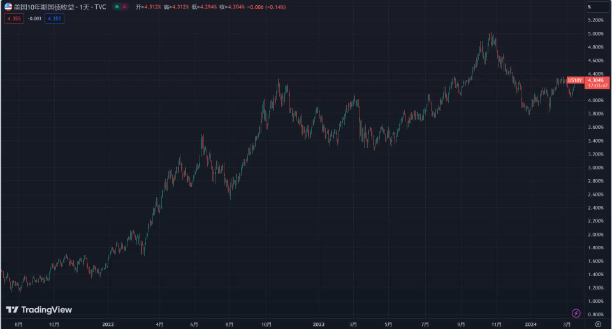
The current DeFi fixed-income projects in the crypto market that are essentially U.S. Treasury bonds in disguise are examined, along with the sources of their 4%, 5%, or even higher returns, and the potential future concerns for these projects against the backdrop of rising U.S. Treasury yields.
Overview of Fixed Income Products Tokenized by Government Bonds
The latest data from the RWA Research Platform rwa.xyz indicates that, as of March 2024, the total market size of tokenized U.S. Treasury bonds is close to $800 million, with an average yield to maturity of 5% on-chain.
Among them, Franklin Templeton's FOBXX product stands out, with a volume of $350 million, occupying more than 40% of the market share. Following closely are the crypto newcomers Ondo Finance (OUSG) and Matrixport (STBT), which hold 15% and 9% of the market share, respectively.
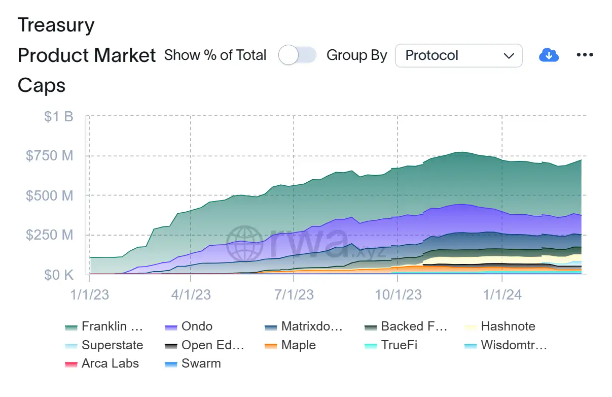
The project involving the 'tokenization' of U.S. Treasury bonds is primarily about linking cryptocurrency assets with U.S. Treasury bonds, that is, Holding tokens on the blockchain is equivalent to owning the underlying financial assets of the traditional market—U.S. Treasury bonds.
The process of user participation on the blockchain is largely similar, taking Matrixport's STBT as an example, itAllows investors (who must undergo a qualified investor verification process) to directly use stablecoins (USDC/USDT/DAI) on the blockchain to mint an equivalent amount of U.S. Treasury bond tokenized products STBTSTBT is fully backed by U.S. short-term Treasury bills and reverse repurchase agreements that mature within 6 months.
As of the time of publication, 99.36% of STBT's reserve assets are comprised of U.S. Treasury securities, making liquidity risk virtually negligible.
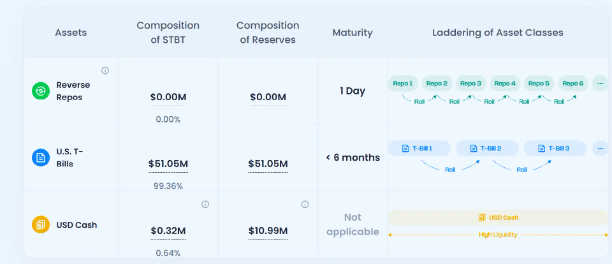
Meanwhile, behind the process of investors minting STBT, the project team exchanges users' stablecoins for fiat currency through stablecoin issuers like Circle, and then third parties purchase government bonds with it.Investors only need to hold STBT as a certificate to receive the "interest income" from U.S. Treasury bonds, which serve as the underlying financial assets.
1 STBT token is equivalent to the net asset value (NAV) of 1 US dollar-denominated asset. Interest is distributed by adjusting the balance of STBT holders every business day, a process known as Rebase, which does not require users to take any additional actions to claim the interest.
Building on this foundation, tokenization on the blockchain can enhance the liquidity of underlying financial assets, as well as provide opportunities for further financialization (such as leverage, lending, etc.) through the use of other DeFi components. This is also the scenario that many projects are currently striving to explore.
MakerDAO's EDSR
MakerDAO is undoubtedly a leading project in the RWA (Real World Assets) sector. However, the proportion of assets that can be used to purchase government bonds within MakerDAO is limited. Previously, MakerDAO has been using $USDC within its PSM (Peg Stability Module) to withdraw and purchase government bonds. However, if there are too many users depositing DAI to earn interest, the interest rate might even fall below that of government bonds.
The current Enhanced DAI Savings Rate (EDSR) stands at 15%, a significant increase recently made by MakerDAO due to a tight supply of DAI. There are a total of 1.4 billion DAI in DSR.This has resulted in the overall utilization rate of the DSR contract (the amount of DAI within the DSR contract / total DAI supply) far exceeding the 20% threshold, reaching as high as 29.8%.
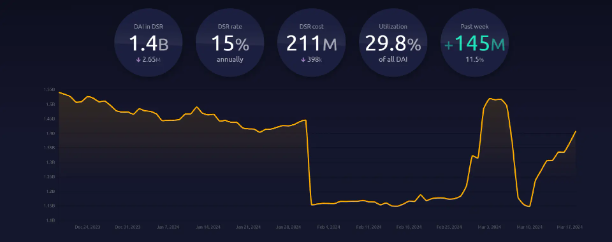
USDM of Mountain Protocol
As a yield stablecoin protocol invested in by Coinbase Ventures, Mountain Protocol has launched its yield stablecoin USDM, which is primarily backed by short-term U.S. Treasury bonds. After completing KYB certification, investors worldwide can seize the opportunity to share in the yields of U.S. Treasury bonds.
In additionUSDM offers daily rewards to users in the form of Rebase, similar to the mechanism of stETH, with a current annual interest rate of 5%and has launched the crvUSD-USDM liquidity pool on Curve, meaning that non-U.S. users can also indirectly purchase and hold USDM to earn profits.
Official documents state that at least 99.5% of its total assets are invested in cash, U.S. Treasury bonds, notes, and other debts issued or guaranteed by the U.S. Treasury Department in terms of principal and interest, as well as repurchase agreements secured by such debts or cash. Therefore, it can be considered fully supported by U.S. Treasury securities, with specific asset details updated monthly.
Angle Protocol's stEUR
As a decentralized stablecoin protocol, Angle Protocol has launched a Euro savings solution, stEUR, which allows users to stake the Euro stablecoin agEUR to obtain stEUR, while earning4% annual yield paid in agEURHowever, this 4% yield is just the initial setting, and it will be regularly updated based on the contract's usage in the future.
It primarily backs short-term Eurobonds with a theoretical yield of around 3.6%, but the agreement involves distributing a portion of the income to agEUR holders, with the current protocol asset return rate at about 1.6%.
And its approach to profit distribution is quite straightforward:The earnings of agEUR holders who have not staked their tokens will be compensated to those who have staked, as not all agEUR holders will stake their tokens to become stEUR holders. Therefore, the earnings of stEUR holders will definitely be more than 1.6%.
For instance, if only 50% of agEUR in circulation is in the stEUR contract, it means that 50% of stEUR is earning all of the agEUR's returns, which is a yield of 3.2%.
Frax Finance's sFRAX
Frax Finance has always been one of the most proactive DeFi projects in aligning with the Federal Reserve, including applying for a Federal Reserve Master Account (FMA) (as noted by Foresight News, the FMA allows holders to possess dollars and directly transact with the Federal Reserve), thereby overcoming the limitations of using $USDC as collateral and the risks of bank failures, making FRAX the closest thing to a risk-free dollar.
On October 12, 2023, Frax Finance launched a treasury vault called sFRAX, which utilizes the yields of U.S. Treasury bonds. By partnering with Lead Bank in Kansas City to open brokerage accounts for purchasing U.S. Treasury bonds, it aims to track the Federal Reserve's interest rates to maintain relevance.
Users can deposit funds into sFRAX and earn an annual yield equivalent to the current IORB rate set by the Federal Reserve, which is around 5.4%.

As of March 18, 2024,The total amount of sFRAX staked exceeds 28 million.
Ondo Finance USDY
In August 2023, Ondo Finance launched a tokenized note, USD Yield (USDY), backed by short-term U.S. Treasury bonds and bank demand deposits. However, USDY is not accessible to U.S. users and institutions, and it can be transferred on-chain 40 to 50 days after purchase.
As a bearer instrument, USDY offers a variable interest rate to its holders, starting at 5% annually. Both individuals and institutions can collaborate directly with Ondo to mint or redeem USDY daily, without any certification requirements.
Ondo has currently launched four types of bond funds, namely the US Money Market Fund (OMMF), Short-Term US Treasury Fund (OUSG), Short-Term Investment Grade Bond Fund (OSTB), and High Yield Corporate Bond Fund (OHYG). Among them, OMMF offers an annualized return of 4.7%, while OUSG can reach a return of 5.5%.
Overall,The configuration objects for most projects are short-term treasury bonds and reverse repurchase agreements of treasury bonds, with the interest rates offered to the public mostly ranging between 4% and 5%.This aligns with the current interest rate space of U.S. Treasury bonds, where part of the high yield is often supplemented by other revenues (such as EDSR), or by sacrificing some non-second-mortgage users to compensate the mortgage users (such as stEUR).
Where do high returns come from?
Where do high returns come from? It's simple, they originate from the increasingly rising 'risk-free interest' of U.S. Treasury bonds (the stEUR and other few projects mentioned above are pegged to the government bonds of the respective countries/regions, the same below).
What we need to clarify is that, as of now, the likelihood of a U.S. national debt default remains extremely low. Therefore, the yield on U.S. Treasury bonds is often considered by the capital markets as a risk-free rate. This implies that holding U.S. Treasury bonds carries a risk profile similar to holding U.S. dollars, yet it offers the added benefit of earning interest.
So, to summarize the core idea behind these fixed-income projects,It involves collecting dollars from users, then investing in U.S. Treasury bonds, and sharing (a portion of) the generated interest with the users.
In a nutshell, these fixed-income projects will launch stablecoins backed by U.S. Treasury bonds. Holders of these stablecoins will be able to earn 'interest income' from the U.S. Treasury bonds, which serve as the underlying financial assets, simply by holding the stablecoins as proof of ownership.
Users who have completed KYC/KYB can mint/exchange at $1, and the project side will purchase corresponding government bonds. This allows stablecoin holders to enjoy the benefits of government bond yields, thereby maximizing the interest transmission from government bonds to stablecoin depositors.
Currently, the yields of U.S. medium and short-term Treasury bonds are close to or exceed 5%, hence the interest rates for the majority of fixed-income projects backed by U.S. Treasuries also fall within the 4%-5% range.
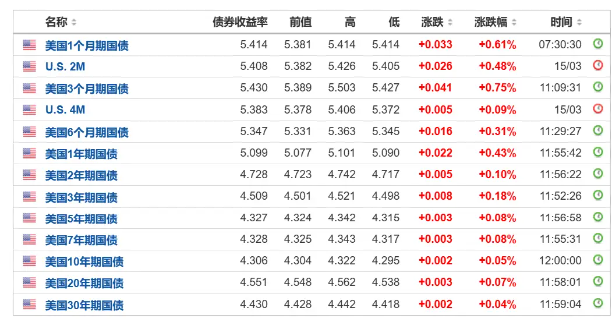
To give a more intuitive understanding through an example—these stablecoins with steady returns are essentiallyDistribute the treasury bond interest earnings monopolized by Tether/USDT to the broad stablecoin holders
It's important to understand that the process of Tether issuing $USDT essentially involves crypto users using US dollars to 'purchase' USDT. When Tether issues 10 billion US dollars worth of $USDT, it means that crypto users have deposited 10 billion US dollars with Tether to obtain that amount of USDT.
After acquiring the $10 billion, Tether does not need to pay interest to the corresponding users.It's essentially like obtaining tangible U.S. dollars from cryptocurrency users at no cost. If these are used to purchase U.S. Treasury bonds, it results in interest income that is both cost-free and risk-free.
According to Tether's second-quarter attestation report, it directly holds $58 billion in U.S. government bonds. With the current yield of around 5% on these bonds, this means Tether earns approximately $2.8 billion annually (about $700 million per quarter) just by holding these assets. The data showing Tether's operating profit exceeding $1 billion in the second quarter further confirms the lucrative nature of this model.
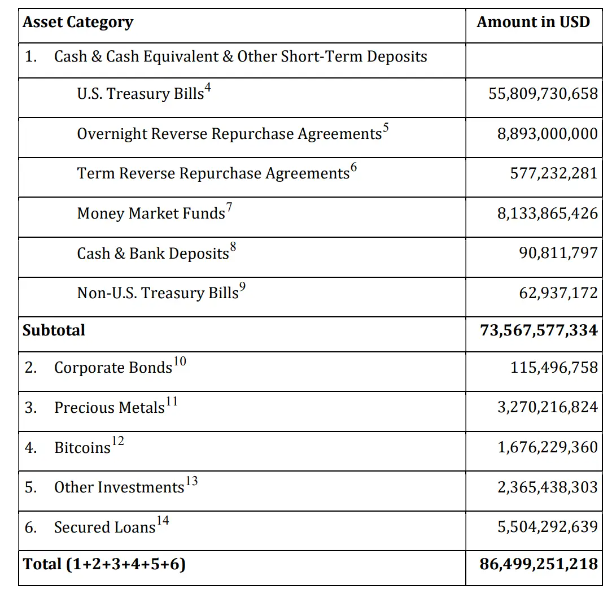
Moreover, these stablecoins can also be freely used in DeFi, including leveraging other DeFi protocol components to fulfill derivative needs such as leveraging and lending.
The Hidden Worries of the U.S. Debt Crisis
Overall, the potential risks faced by fixed-income projects supported by government bonds and the stablecoins they issue mainly stem from three aspects:
The psychological risk of continued decline in U.S. Treasury pricesIf the value of U.S. Treasury bonds does not cover the market value of stablecoins, once it falls to a psychological threshold, it could trigger a de-pegging avalanche.Liquidity risk under the mismatch of maturities. If the crypto market experiences significant fluctuations, users selling off stablecoins to replenish liquidity could lead to a bank run scenario;
Custodial institution risk. Overall, there is a significant reliance on trust in the custodial institutions of underlying government bond assets;
Risks of U.S. Treasury Bonds Decline
As is widely known,The yield of bonds and their prices are two sides of the same coin, so when the text above mentions that the yield on U.S. Treasury bonds continues to rise, reaching new highs for the period, it also implies that the prices of U.S. Treasury bonds are falling during the same period.,setting a new low for the period.
Including the 10-year U.S. Treasury yield breaking through 5% mentioned at the beginning of the text, the underlying reasons are inseparable from the fact that since the debt ceiling negotiations were passed in June this year, the scale of U.S. Treasury issuance has far exceeded historical levels for the same period:
From a data perspective, as of February 2024, the size of the U.S. government debt reached $34.4 trillion, growing by over $3 trillion in less than a year, which has disturbed the market liquidity due to the supply and demand relationship of government bonds.
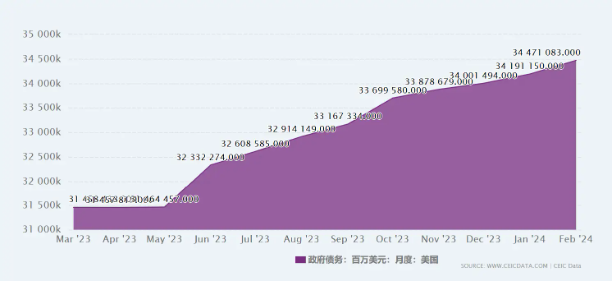
This also implies that,The market value of the underlying financial assets (i.e., U.S. Treasury bonds) that support these stablecoin yields is actually depreciating as yields continue to rise. However, as long as they are not actually sold, it's merely a paper loss, presenting a latent 'insolvency' situation.
According to forecasts, the issuance of U.S. Treasury bonds is expected to remain high in the fourth quarter. If this scenario of supply and demand divergence continues, there is no doubt that the prices of U.S. Treasuries will still be under pressure.
This is also a critical point where risks accumulate—if U.S. Treasury yields continue to rise, the prices of U.S. Treasuries will keep falling. Once investors realize that the underlying asset prices have shrunk to an unacceptable level, reaching a psychological threshold, and start redeeming, then 'paper losses become real losses,' and insolvency becomes a reality, ultimately triggering an avalanche.
Liquidity Risk
Liquidity risk is also a potential technical risk worth paying attention to, in my opinion. If the fall in U.S. Treasury bond prices leads to a passive decrease in the asset value backing stablecoins, then it is through an imbalance in the asset-liability structure that this issue is actively exacerbated.
The core point is just one,The project owners receive their returns from US Treasury bonds upon maturity, but for users holding the 'tokenized' RWA assets of US Treasury bonds (i.e., the stablecoins they issue), their returns can be redeemed without waiting for the bonds to mature. How is this possible?
For instance, taking the 10-year U.S. Treasury bonds that have just broken through a 5% yield as an example, even if the project side buys them now, they would have to wait until maturity in 10 years to secure the average annualized return of 5%. However, at the same time, holders of on-chain tokens can almost instantly cash out. What's the reason behind this?
Maturity mismatch.
From the analysis of the sources of high returns mentioned above, it is evident that the primary use of stablecoins launched by various entities is not as a direct medium of exchange, but rather to provide returns for holders. Therefore, the underlying financial assets are primarily government bonds of various maturities.
To ensure the risk and return of the investment portfolio are well-matched, offering as high a fixed income as possible to token holders on the blockchain (temporarily setting aside the inversion of short and long-term Treasury yields, the same below) is undoubtedly achieved through a combination of 'long-term bonds' and 'short-term bonds'. This approach balances liquidity (to prevent user redemptions) with returns (to provide a fixed income).
There's nothing wrong with this. One of the fundamental aspects of finance is the mismatch in maturities, which is one of the main sources of income for the financial industry. However, it's important not to forget that this is also a significant source of liquidity risk.
Let's just imagine a scenario—The cryptocurrency market has experienced significant fluctuations, leading to widespread liquidations or near-liquidations among investors. Holders may resort to selling RWA to replenish liquidity.
Under such liquidity risk shocks, the project party can only recover liquidity by selling U.S. Treasury bonds, starting naturally with short-term bonds that have good liquidity and small discounts. However, once the demand for redemption exceeds the remaining amount of short-term bonds, they will have no choice but to sell long-term bonds at a discount before maturity.
Especially, the underlying financial assets (i.e., U.S. Treasury bonds) are only traded during working hours on weekdays, but tokenized assets on the blockchain are traded 24/7 without interruption.This mismatch in transaction timing could also potentially hinder project operators from selling U.S. Treasury bonds in a timely manner to recover liquidity, further exacerbating selling pressure during market fluctuations.
At this point, the project operators have two choices: either reduce the advertised fixed interest rate or silently accrue losses. However, once the advertised fixed interest rate is reduced, it could likely trigger a crisis of trust, leading to a bank run and exacerbating the selling frenzy. This could easily result in stablecoins becoming unpegged, thereby intensifying liquidity risks.
Does it look very familiar to you?
That's right,This is almost exactly the same chain of risks and transmission pathways that began in the Silicon Valley Bank crisis in March this year.This has also led to the bankruptcy of several banks, including Silicon Valley Bank and Signature Bank, nearly causing systemic risk.
Custodial Institution Risk
Of course, to some extent, the tokenization of U.S. Treasury bonds in the cryptocurrency market, a fixed-income project, is also bidirectionally linked to the traditional financial market. The extreme volatility of the cryptocurrency market could potentially be transmitted to the traditional financial market through the 'RWA—Treasury bonds' conduit.
However, the scale of fixed-income projects involving the 'tokenization' of U.S. Treasury bonds is still very limited at present, and the liquidity of the U.S. Treasury market is more than sufficient to handle the impact of such sales. Therefore, it is currently difficult for such sell-offs to affect the prices of underlying financial assets.
This leads us to another potential risk factor—The reliability of custodial institutionsTaking Circle, a leading crypto project with a massive holding of U.S. Treasuries, as an example, it is relatively safe as it is custodied by U.S. financial institutions like BlackRock (Circle Reserve Fund).
Currently, stablecoins supported by a range of fixed-income government bonds largely depend on the trust in the underlying government bond custody institutions. The disclosure of information is also quite limited, which is an undeniable risk factor.
Summary
In the midst of a rate hike feast, will this brutal pleasure ultimately end in brutality?
For the majority of ordinary investors, fixed-income projects that tokenize U.S. Treasury bonds through RWA (Real World Assets) channels, despite often having certain entry requirements, present a rare opportunity to partake in the benefits of U.S. Treasury yields.
It can also introduce more abundant funds and high-quality underlying assets to the DeFi sector and the crypto market, which is a positive factor for the entire cryptocurrency market.
However, like cicadas sensing the autumn breeze before it stirs, the surge in short-term U.S. Treasury supply since June has allowed the U.S. government to navigate through the awkward situation of issuing bonds to alleviate funding gaps. Therefore, the aforementioned 5% threshold, while being a significant psychological barrier, also implies that it's unlikely for the actual yield to remain in the current high range for an extended period.
For users currently hoping to gain profits through the 'tokenization' of U.S. Treasury bonds, it's undoubtedly necessary to manage expectations and control risks accordingly:
On one hand, it's necessary to be clearNo one can guarantee that the yields on U.S. Treasury bonds of 4%, 5%, or even higher will continue indefinitely.There exists a critical value in the dynamic relationship between 'yield-price', where if the price of U.S. Treasury bonds falls below a certain point, the situation where the asset value (of U.S. Treasury bonds) does not cover the debt (stablecoin market value) could materialize, potentially leading to a rapid de-pegging and collapse.
On the other hand,A project offering a fixed return rate of over 5% could indicate a more complex 'duration mismatch' between long and short-term debts.As mentioned above, this also means that the higher the fixed yield of a project, the higher the potential liquidity risk, and the likelihood of bank runs and stampedes increases accordingly.
There is no eternal feast in the financial markets, and this is even more true for the cryptocurrency industry.
To take and to give, all converging to one place, those of us who have experienced UST/Anchor might understand even more clearly,No matter how grand the narrative of high returns, if one cannot exit completely and intact, it will all be but a mirage.
Overall, the cryptocurrency market has essentially reached a consensus. Regardless of the future direction of the U.S. Treasury market, at least under the current surge in Treasury yields, products like STBT/USDV, OUSG, and other fixed-income and yield-stable coin products based on U.S. Treasuries are stirring the waters.
The future always lies beyond imagination. Perhaps looking back in several years, this will be seen as a pivotal moment in history. Players like USDV/USBT and OUSG could introduce significant variables to both the cryptocurrency market and the traditional financial system, making it an exciting prospect.
Time will give us the answer.
